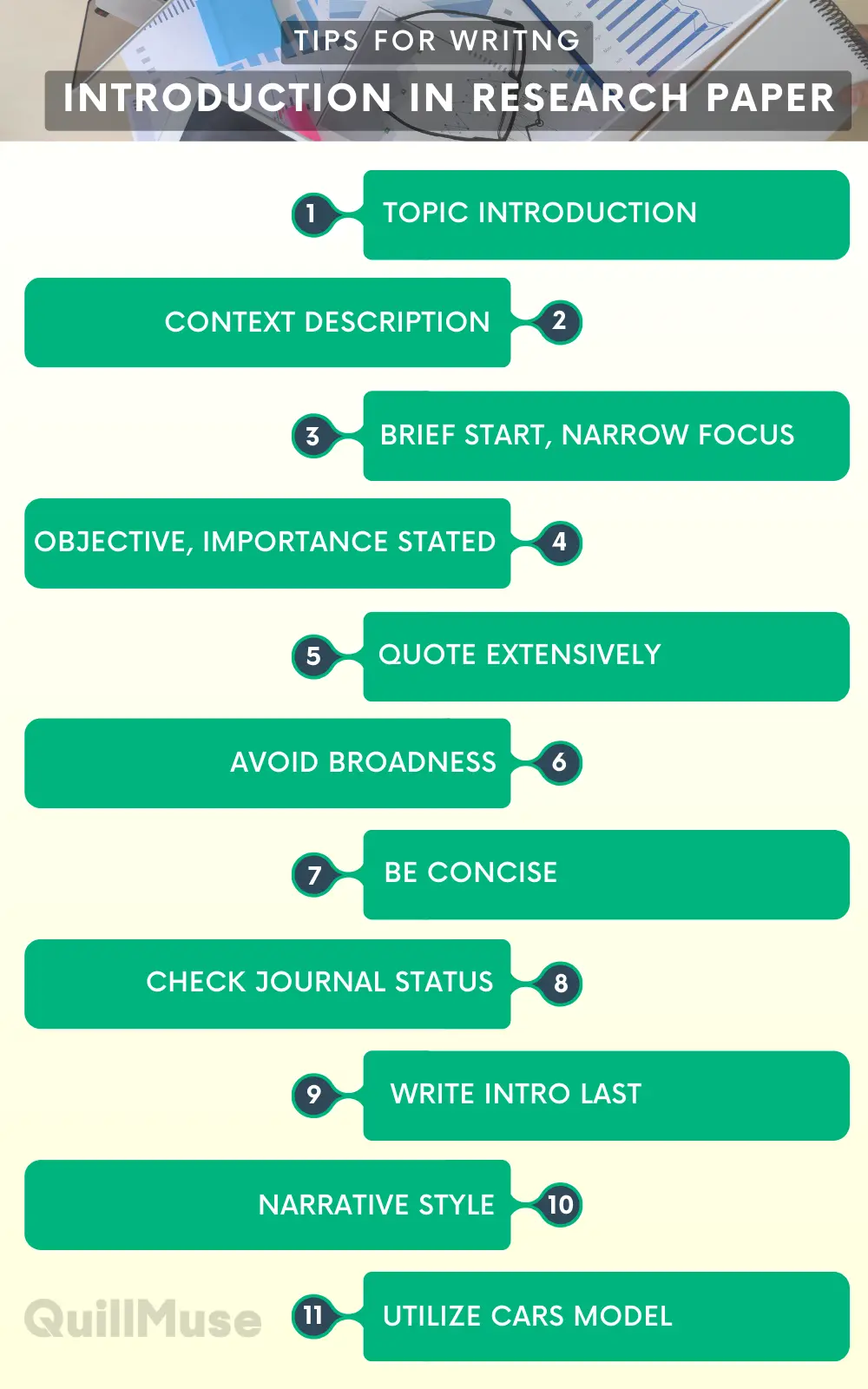How to Write a Research Paper Introduction
Learn how to write a research paper introduction with expert guidance.

Zannat Mou
Last updated on Mar 13th, 2024

When you click on affiliate links on QuillMuse.com and make a purchase, you won’t pay a penny more, but we’ll get a small commission—this helps us keep up with publishing valuable content on QuillMuse. Read More.
Table of Contents
We write different types of papers for academic and professional reasons. Research paper is one of the most important papers and it is different from other papers. There are different types of rules for writing a research paper, the first part is the introduction. Through this article, we will try to tell you how to write an introduction for a research paper beautifully.
Introduction
Before starting to write any papers, especially research papers one should know how to write a research paper introduction. The introduction is intended to guide the reader from a general subject to a specific area of study. It establishes the context of the research being conducted by summarizing current understanding and background information on the topic, stating the purpose of the work in the form of a thesis, question, or research problem, Briefly explaining your rationale, your methodological approach, highlight the potential findings your research may reveal, and describe the remaining structure of the paper.
A well-written introduction is imperative since, essentially, you never get a second chance to form a great first impression. The opening passage of your paper will give your audience their introductory impression, almost the rationale of your contention, your composing style, the general quality of your investigation, and, eventually, the legitimacy of your discoveries and conclusions. A vague, disorganized, or error-filled introduction will create a negative impression on the readers. While a brief, engaging, and well-written introduction will begin your readers off considering profoundly your expository abilities, your writing style, and your research approach.
Tips for Writng an Introduction in Research Paper

Introduce your topic
This is a significant part of how to write an introduction for a research paper. The first task of the introduction is to tell the reader what your topic is and why it is interesting or important. This is usually done with a strong opening hook.
A hook is a strong opening sentence that conveys relevance to your topic. Think of an interesting fact or statistic, a powerful statement, a question, or a brief anecdote that will make readers wonder about your topic.
Describe the context
This introduction varies depending on your approach to your writing. In a more argumentative article, you will explore the general context here. In a more empirical paper, this is a great place to review previous research and determine how your research fits together.
Start briefly, and narrow down
The first thing of a research paper introduction is, to briefly describe your broad parts of research, then narrow in on your specific focus. This will help position your research topic within a broader field, making the work accessible to a wider audience than just experts in your field.
A common mistake when writing a research paper introduction is trying to fit everything in at once. Instead, pace yourself and present each piece of information in the most logical order the reader can understand. Typically, this means starting with the big picture and then gradually getting more specific with the details.
For your research paper introduction, you should first present an overview of the topic and then focus on your specific paper. This “funnel” structure naturally includes all the necessary parts of what should be included in a research paper introduction, from context to appropriate or research gaps and finally to relevance.
State Objective and Importance
Papers abandoned because they “do not demonstrate the importance of the topic” or “lack a clear motivation” often miss this point. Say what you want to achieve and why your readers should want to know whether you achieved it or not.
Quote generously
Once you have focused on the specific topic of your research, you should detail the latest and most relevant literature related to your research. Your literature review should be comprehensive but not too long. Remember, you are not writing a review. If you find your introduction is too long or has too many citations, a possible solution is to cite journal articles, rather than cite all of the individual articles that have been summarised in the journal.
Do not Keep it broad
Try to avoid lengthy introductions. A good target is between 500 and 1,000 words, although checking the magazine’s guidelines and back issues will provide the clearest guidance.
Be concise
The introduction is not lengthy or detailed; rather, they are initiating actions. Introductions are best when they get to the point: save the details in the body of the document, where they belong.
The most important point of a research paper introduction is that they are clear and easy to understand. Writing at length can be distracting and even make your point harder to understand, so cut out unnecessary words and try to express things in simple terms that everyone understands. understandable.
Check journal condition
Many journals have specific assertions in their author instructions. For example, a maximum of one word may be stated, or instructions may require specific content, such as a supposition statement or a summary of your key findings.
Write the introduction to your research paper at the last moment
Your introduction may appear first in a research paper, but the general advice is to wait to write it until everything else has been written. This makes it easier for you to summarize your article because at this point you know everything you’re going to say. This also eliminates the urge to include everything in the introduction because you don’t want to forget anything.
Additionally, it is especially helpful to write an introduction after your research paper is finished. The introduction and conclusion of a research paper have similar topics and often reflect the structure of each topic. Writing the conclusion is also generally easier thanks to the pace created by writing the rest of the paper, and the conclusion can guide you in writing the introduction.
Make your introduction narrative style
Although not always appropriate for formal writing, using a narrative style in the introduction of your research paper can do a lot to engage readers and engage them emotionally. A 2016 study found that in some articles, using narrative strategies improved how often they were cited in other articles. Narrative style involves making the paper more personal to appeal to the reader’s emotions.
- Use first-person pronouns (I, we, my, our) to show that you are the narrator expressing emotions and feelings in the text setting up the scene.
- Describe the times and locations of important events to help readers visualize them.
- Appeal to the reader’s morality, sympathy, or urgency as a persuasive tactic. Again, this style will not be appropriate for all research paper introductions, especially those devoted to scientific research.
However, for more informal research papers and especially essays, this style can make your writing more interesting or at least interesting, perfect for making readers excited right from the beginning of the article.
Use the CARS model
British scientist John Swales developed a method called the CARS model to “generate a search space” in the introduction. Although intended for scientific papers, this simple three-step structure can be used to outline the introduction to any research paper.
Explain the background of your topic, including previous research. Explain that information is lacking in your topic area or that current research is incomplete.
Explain how your research “fills in” missing information about your topic.
the research findings and providing an overview of the structure of the rest of the paper, although this does not apply to all research papers, especially those Unofficial documents.
Six Essential Elements of How to Write a Research Paper Introduction
1. Topic Overview
Start with a general overview of your topic. Refine your outline until you address the specific topic of your article. Next, mention any questions or concerns you have about the case. Note that you will address these in the article.
2. Previous research
Your introduction is the perfect place to review other findings about your topic. Includes both old and modern scholars. This general information shows that you are aware of previous research. It also presents previous findings to those who may not have that expertise.
3. A justification for your article
Explain why your topic needs to be discussed now. If possible, connect it to current issues. Additionally, you can point out problems with old theories or reveal gaps in current research. No matter how you do it, a good reason will keep readers interested and demonstrate why they should read the rest of your article.
4. Describe the method you used
Tell about your processes to make your writing more trustworthy. Identify your goals and the questions you will answer. Reveal how you conducted the research and describe how you measured the results. Also, explain why you made the important choices.
5. A thesis statement
Your main introduction should end with a thesis statement. This statement summarises the ideas that will run throughout your entire research paper. It must be simple and clear.
6. An outline
It is an adequate idea of how to write an introduction for a research paper.
The introduction usually ends with an overview. Your layout should quickly present what you plan to cover in the following sections. Think of it as a road map, guiding readers to the end of your article.
What is the purpose of the introduction in a research paper, and why is it considered crucial?
The purpose of the introduction in a research paper is to guide the reader from a general subject to a specific area of study. It establishes the context of the research by summarizing current understanding, stating the purpose of the work, explaining the rationale and methodological approach, highlighting potential findings, and describing the paper’s structure. It’s considered crucial because it forms the reader’s first impression and sets the tone for the rest of the paper.
How can I effectively use a hook to engage readers in my research paper introduction?
Using a hook, such as an interesting fact, a powerful statement, a question, or a brief anecdote, can effectively engage readers in your research paper introduction. A hook captures the reader’s attention and makes them curious about your topic, encouraging them to continue reading.
How long the introduction should be in a research paper?
While there’s no strict word count, a good target for a research paper introduction is between 500 and 1,000 words, although you should check the specific guidelines provided by the journal you’re submitting to. It’s recommended to write the introduction after the rest of the paper has been completed. This way, you have a comprehensive understanding of your research, making it easier to summarize and guide your readers effectively.
Conclusion
These are the important tips and tricks on how to write an introduction for a research paper properly. If you maintain these rules we believe that you will be able to write an excellent introduction in your research paper.
How we've reviewed this article
Our content is thoroughly researched and fact-checked using reputable sources. While we aim for precision, we encourage independent verification for complete confidence.
We keep our articles up-to-date regularly to ensure accuracy and relevance as new information becomes available.
- Current Version
- Mar 13th, 2024
- Oct 14th, 2023



